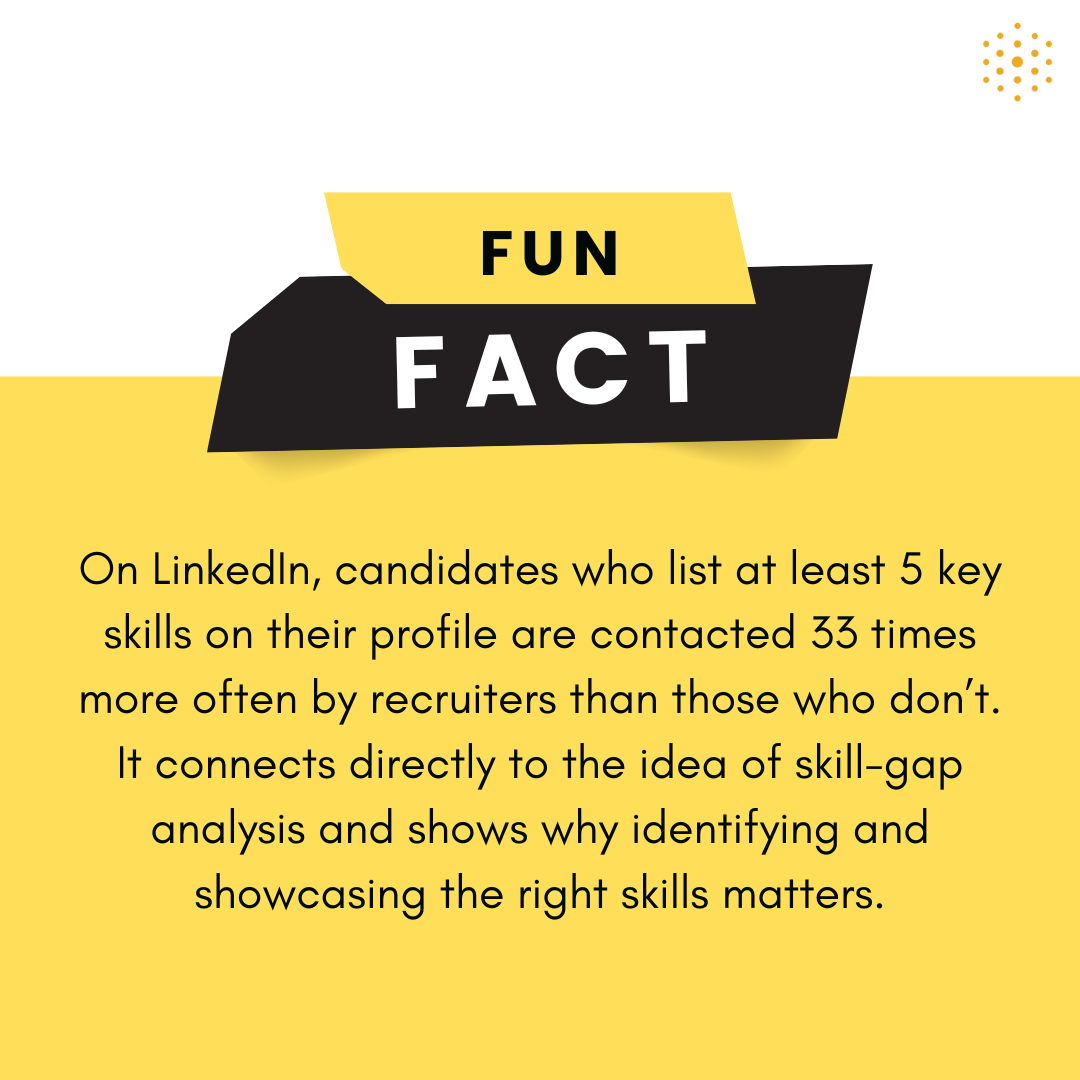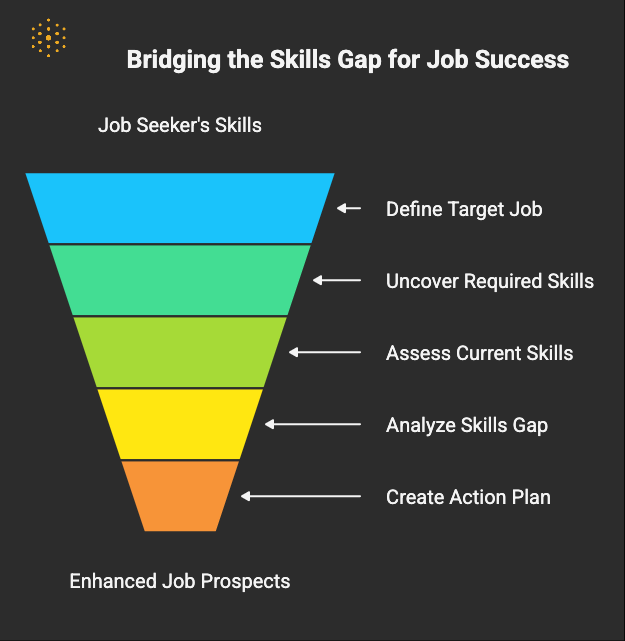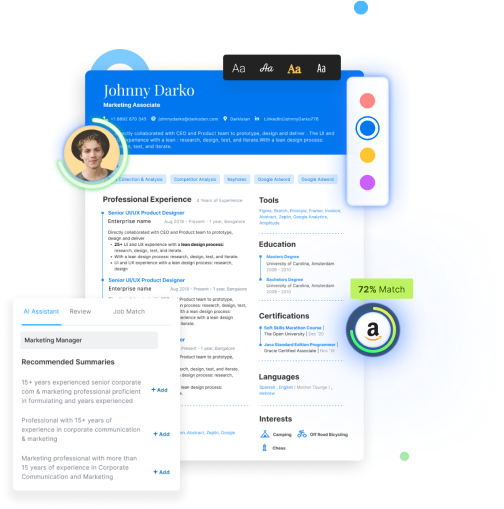How to perform a skills gap analysis to match a target role?
Define a target role, extract required skills from job postings and profiles, then list your current skills with proof. Compare to mark Have, Partial, or Gap; plan learning for misses, then update your resume and profile to show progress.
Are you sending out dozens of applications but getting few responses? It’s a frustrating experience that leaves many job seekers feeling stuck.
And the reality is, nearly half of all workers (44%) will need to update or retrain their skills in the next five years to keep pace with changing job demands.
This isn’t about lacking talent, it’s about aligning your skills with what employers are actively looking for.
A personal skill-gap analysis helps you do exactly that by showing where you stand today and creating a clear roadmap to close the gap.
Here's how to do it in 5 simple steps.
Step 1: Define Your Target Job
You can't hit a target you can't see. The first step is to get crystal clear on the specific job or career path you want.
"A marketing job" is too vague. "A Digital Marketing Manager role focused on SEO and content strategy" is specific and actionable.
- Research Job Titles: Browse LinkedIn and job boards to find 2-3 specific job titles that excite you and align with your long-term career goals.
- Identify Target Companies: Make a list of 5-10 companies you'd love to work for. What kind of roles do they typically hire for?
Having a clear goal focuses your efforts and makes the next steps much more effective.
Also Read: What are some of the best digital marketing jobs?
Step 2: Uncover the Skills That Job Requires
Now that you have a target, it's time to play detective. Your mission is to create a master list of the skills required for that role. This will become your roadmap.
Here’s how to find them:
- Analyze Job Descriptions: Find 5-10 job postings for your target role. Copy and paste the "Requirements" or "Qualifications" sections into a document. Look for recurring skills and keywords. Pay attention to both hard skills (like 'Salesforce' or 'Python') and soft skills (like 'stakeholder communication' or 'leadership').
- Study Resume Examples: Look at resumes of people who already have the job you want. What skills do they highlight?
- Check LinkedIn Profiles: Find people on LinkedIn who hold your target job title at your target companies. Look at their "Skills" section to see what's endorsed and what they emphasize in their experience descriptions.
By the end of this step, you should have a detailed list of about 10-15 core skills for your desired job.

Step 3: Honestly Assess Your Current Skills
This step requires honest self-reflection. It’s time to create a list of what you bring to the table right now. Don't be shy, but be realistic.
- Create Your "Master Skill List": Go through your entire work history, education, and any personal projects. Write down every skill you've used.
- Find Proof: For each skill, think of a specific example where you used it. Instead of just "Communication," write "Presented monthly reports to a team of 15." This helps you validate your skill level.
- Ask for Feedback: Reach out to a trusted former manager or mentor. Ask them, "When you worked with me, what were my strongest skills? What areas did you see for growth?"
Step 4: Analyze Your Personal Gap
Now, you'll compare your two lists: the skills the job requires (Step 2) and the skills you currently have (Step 3).
Create a simple table with three columns: "Required Skill," "My Status," and "Evidence/Notes."
| Required Skill | My Status (Have It, Partial, or Gap) | Evidence / Notes |
|---|---|---|
| Data Visualization (Tableau) | Partial | Used it for one project, but not an expert. |
| Client Presentations | Have It | Presented to 5+ key clients in my last role. |
| SEO Keyword Research | Gap | No direct experience with tools like Ahrefs. |
This table gives you a powerful visual of your strengths and weaknesses. You now know exactly which skills to highlight on your resume and which ones you need to work on.
Step 5: Create Your Action Plan to Bridge the Gap
This is the final, most important step. Based on your analysis, create a plan to develop the skills you're missing and learn how to showcase them effectively.
Your action plan should include:
- Learning: For the skills you marked as "Partial" or "Gap," find ways to learn them. This could be through online courses on Coursera or Udemy, professional bootcamps, or free tutorials. Getting a new certification is a fantastic way to validate a skill.
- Practicing: You need to apply your new knowledge. Offer to help a friend with a project, take on freelance work, or start a personal project that uses the skill. Even volunteer work can be a great way to gain experience.
- Showcasing: As you build these skills, update your professional profiles. The ultimate goal is to get these new qualifications in front of recruiters. It's time to learn how to write a resume that is tailored to the job description and packed with the keywords you discovered in Step 2. Then, apply the same principles to your optimize your LinkedIn profile.

Final Thoughts
Bridging your skill gaps isn’t essentially just about landing your next job, it’s about building long-term career confidence.
By identifying where you stand and taking intentional steps to grow, you can transform from an overlooked applicant into the candidate employers are eager to hire.
And if you’re ready to fast-track that process, Hiration can help.
Our AI-powered solutions make it easy to analyze job descriptions, tailor your resume, and even practice interviews, all designed to align your skills with what recruiters are looking for.
This tailored approach has already helped 1M+ job seekers align their profiles with employer expectations and get noticed faster.
Take the first step today and turn your career goals into reality!
Frequently Asked Questions
-
What is a skills gap analysis?
You compare the skills a target job requires with your current skills to spot gaps and plan growth. It shows where you stand today and creates a clear roadmap to close the gap.
-
How do you perform a skills gap analysis?
Follow 5 steps: define your target job, uncover required skills, assess your current skills, analyze your personal gap, and create an action plan.
-
How should you define your target job?
Get specific about the role. Research job titles and identify target companies; find 2-3 specific job titles and list 5-10 companies you’d love to work for.
-
How do you uncover the skills a job requires?
Analyze multiple postings for your target role and note recurring requirements. Find 5-10 job postings, and include hard skills like 'Salesforce' or 'Python' and soft skills like 'stakeholder communication' or 'leadership'.
-
How many core skills should you identify for a target job?
Aim for about 10-15 core skills for your desired job.
-
How do you assess your current skills honestly?
List every skill from your work, education, and projects, and back each with specific examples. Ask a trusted former manager or mentor for feedback on strengths and growth areas.
-
How do you analyze your personal skills gap?
Compare the job's required skills with your current skills and mark each as Have It, Partial, or Gap. Create a table with 'Required Skill,' 'My Status,' and 'Evidence/Notes'.
-
What’s a common mistake when defining a target job?
Being too vague. For example, 'A marketing job' is too vague; 'A Digital Marketing Manager role focused on SEO and content strategy' is specific and actionable.
-
What’s the difference between hard and soft skills in this process?
Include both types. Hard skills can be 'Salesforce' or 'Python', while soft skills include 'stakeholder communication' or 'leadership'.
-
How do you create an action plan to bridge the gap?
Focus on learning, practicing, and showcasing. Use courses or bootcamps, projects or volunteer work, then tailor your resume to the job description and optimize your LinkedIn profile.



